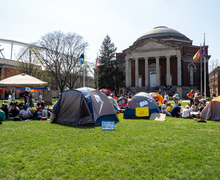There needs to be more appreciation for the lost beauty of Archbold Stadium
Daily Orange File Photo
Archbold Stadium's history has been pushed to the side by the Carrier Dome. Students should know more about what the stadium meant to central New York.
When people think of sporting venues in New York state, a few places come to mind: The original Yankee Stadium (which revolutionized entertainment venues), Madison Square Garden (“The World’s Most Famous Arena”) and The Polo Grounds nestled under Coogan’s Bluff in northern Manhattan. But, Syracuse University’s own Archbold Stadium was called “the greatest athletic arena in America.”
The field where Ernie Davis and Jim Brown became well-known figures was once an integral part of SU campus, standing where the Carrier Dome currently is today.
With a $600,000 donation from John Archbold, the vice president at Standard Oil Company and a member of SU’s board of trustees, the university built a stadium into the hill behind Crouse College between 1906-07. If the Archbold name sounds familiar, this is the same man who funded the construction of Archbold Gymnasium, the former name of the current gym and the reason it is called the Barnes Center at The Arch today.
The stadium stood 670 feet long and 475 feet wide, according to cuse.com. To put that into perspective, the Dome is only 22 feet wider and was 100 feet shorter than Archbold. Its 18 rows of seating was built to seat 20,000 people, but often more than double the spectators managed to squeeze in and cheer on the Orange, cuse.com said, making for an incredible home field advantage. In their championship winning 1959 season, the Orange went undefeated at Archbold, going 5-0 within the stadium.
At the time of its completion, it ousted Harvard Stadium as the largest concrete stadium in the country and was one of three concrete stadiums in the world. But the most impressive feature of the stadium was its grand entrance and overall architectural beauty — fans entered the bowl-shaped stadium by walking under a 40-foot tall cement arch supported by two towers.
Due to stricter fire codes and threats to be demoted to a lower athletic division, Archbold Stadium had to be torn down in 1979 to make room for the Dome, which is now home to SU football, lacrosse and basketball. This also made Manley Field House — the original home to SU basketball — obsolete for fans, now becoming a part of the SU athletic training complex.
When strolling down the Einhorn Family Walk, the original row of SU stands out for its beautiful, unique and historic architecture such as the Hall of Languages and Crouse College. On the other side of the walk, however, is contrasted with Bird Library and the Newhouse School of Public Communications — two bland, hulking buildings built after the mid-20th century that tower over the pedestrians below and stick out on campus. Similarly, the Dome, while beloved by many current SU students and community, lacks architectural attractiveness and is just a reminder of what once was. Archbold Stadium, on the other hand, fit seamlessly into campus and was an aesthetically pleasing and beautiful athletic stadium.
More than 40 years since the construction of the Dome, we cannot bring Archbold back. But when SU students pack the Dome on game days to create a home field advantage like no other in college sports, they should also know and appreciate SU’s history.
Dalton Baxter is a sophomore applied data analytics major. His column appears biweekly. He can be reached at dwbaxter@syr.edu.
Published on April 25, 2022 at 11:35 pm





